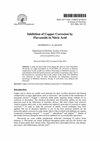Characterization of Extracellular Dextranase from a Novel Halophilic Bacillus subtilis NRC-B233b a Mutagenic Honey Isolate under Solid State Fermentation
引用次数: 29
Abstract
Bacillus subtilis NRC-B233b was isolated from Libyan honey sample proved to be a potent dextranase producer by applying solid state fermentation and utilizing corn flour as the sole carbon source. The optimized culture conditions for dextranase productions were 37°C, pH 10, 32 h, and 20% (v/w) moisture content. A unique character of this isolate is its ability to produce steady dextranase irrespective to the presence of NaCl in the medium. The addition of 0.175 Mm CrCl3 increased the enzyme production by about 4.5 fold. Further improvement in enzyme production was achieved by simple UV mutation which increased the enzyme production up to about 2842 U/g. The crude extract has been partially purified about 112-fold from crude extract by only two purification steps involving ultra-filtration. The partially purified dextranase showed its maximum activity at pH 9.2 and 70°C. It retained full activity (100%) at 75°C for one hour. Dextranase activity increased about 4 fold in the presence of 10% NaCl. This enzyme showed variable degradation effect on different types of dextran and its derivatives. The treatment of viscous sugar cane juice with the enzyme preparation resulted in clear visual dextran hydrolysis. These results suggest that the dextranase produced by Bacillus subtilis NRC-B233b is industrially applicable.新型嗜盐枯草芽孢杆菌NRC-B233b致突变蜂蜜分离物胞外葡聚糖酶的固态发酵特性
从利比亚蜂蜜样品中分离到枯草芽孢杆菌NRC-B233b,以玉米粉为唯一碳源,采用固态发酵的方法,证实了枯草芽孢杆菌NRC-B233b是一种有效的葡聚糖酶产生菌。葡聚糖酶的最佳培养条件为37℃、pH 10、32 h、20% (v/w)的含水量。该分离物的一个独特特性是无论培养基中是否存在NaCl,它都能产生稳定的葡聚糖酶。添加0.175 Mm CrCl3可使酶产量提高约4.5倍。通过紫外诱变进一步提高了酶的产量,使酶的产量提高到2842 U/g左右。粗提取物仅通过两个涉及超滤的纯化步骤就从粗提取物中部分纯化了约112倍。部分纯化的葡聚糖酶在pH 9.2和70℃条件下活性最高。在75℃下保存1小时,仍能保持100%的活性。10% NaCl处理下,葡聚糖酶活性提高了约4倍。该酶对不同类型葡聚糖及其衍生物具有不同的降解作用。用该酶制剂对粘性甘蔗汁进行处理后,葡聚糖水解效果明显。这些结果表明,枯草芽孢杆菌NRC-B233b生产的葡聚糖酶具有工业应用价值。
本文章由计算机程序翻译,如有差异,请以英文原文为准。
求助全文
约1分钟内获得全文
求助全文

 求助内容:
求助内容: 应助结果提醒方式:
应助结果提醒方式:


